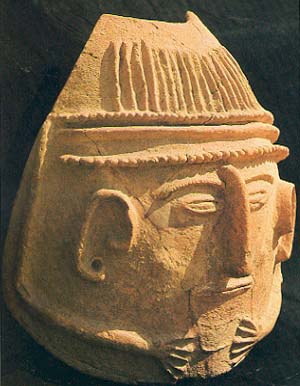Image Details

Israel Department of Antiquities and Museum
The vertical fluting on the headdress represents feathers, reeds or leather strips. Beneath it are two rows of knobs separated by a plain band. This headgear closely resembles the feathered headdresses of Philistine warriors depicted on wall reliefs of Ramesses III at Medinet Habu in Egypt, suggesting that this coffin was left at Beth Shean by Philistines. The Bible, too, supports this conclusion by reporting that after the Philistines killed Saul and his sons at Mt. Gilboa, five miles west of Beth Shean, the Philistines dwelt in the cities from which the Israelites fled and they fastened [Saul’s] body to the wall of Beth Shean (1 Samuel 31:7–10).
This coffin lid is evidence that Philistine settlement and influence in the early Iron Age spread from their cities on the southern coastal plain at least as far north as Beth Shean.—Ed.
